An infection with the dangerous Search Baron may lead to serious security issues. Victims can restore and protect their Mac by following our complete removal guide.
Search Baron is yet another nasty application that hijacks browsers installed on Mac devices. It is a hoax search engine defined as a browser hijacker. The potentially unwanted program has been spotted in active contamination campaigns. The moment it runs on a Mac, it accesses installed browsers and alters essential settings there. Afterward, the homepage, new tab page, and default search engine display the SearchBaron hoax search engine. A browser extension of the same name may be installed behind your back. Files associated with this annoying site may endanger the overall macOS security while running on it. Oftentimes, unwanted programs collect personal and non-personal data and transfer it to remote servers.
Remove Search Baron and Restore MacOS Security
Manual Removal Guide
Skip all steps and download anti-malware tool that will safely scan and clean your PC.
Run a free scan and check if your Mac is infected with malware.
SpyHunter for Mac Scanner feature is free. Other features are paid. Here you can review its EULA and Privacy Policy.
Distribution of Search Baron Mac
Search Baron is a new malware which has been reported in various attacks worldwide. At the moment there is no single tactic that is known to be spreading its infection files. Targets may be reached via fake pop-ups for software updates, other nasty freeware, torrent websites, and spam emails.
A common way of setting browser hijacker attacks is the use of corrupted websites. They may directly distribute malicious files containing scripts that lead to an infection. Other possible case scenarios include:
- Infected Software Installers ‒ The criminals craft malicious packages made out of legitimate software installers. They are taken from the official vendor download sites, modified and then posted on online sites or attached (either as file attachments) or linked in the email messages.
- Infected Documents ‒ They represent dangerous files that usually come in the form of some of the most popular document types: rich text documents, spreadsheets and databases. When the users open them up a notification prompt will ask them to enable the built-in scripts (macros). If this is done then the malware is installed on the victim computer.
The malware browser plugins can be uploaded to hacker-controlled sites and P2P networks like BitTorrent as well. The hacker operators frequently utilize template design, text and images to create portals that look like legitimate download sources. They may also use domain names that are very similar to legitimate sites and advertise them via pop-ups or ad networks.
The browser hijacker code associated with the Search Baron can be found in numerous malware toolbars. They are usually made for the most popular web browsers: Mozilla Firefox, Google Chrome, Safari, Microsoft Edge. They can be distributed on such download sites or even on the browsers repositories (such as the Chrome Web Store for Google Chrome) using fake developer accounts.
Impact of Search Baron on Mac
The Search Baron has been found to infect numerous Mac users worldwide. It impacts the most popular web browsers used on macOS. The infection happens in a stealth manner and it may affect the most popular applications including Safari, Google Chrome, Opera and Mozilla Firefox.
Once it has infected the target browser the Search Baron changes important settings that are related to the way the browser operates by default. The malware code modifies the default home page, new tabs page, and search engine to redirect the traffic through the hacker-provided address. At the moment the Search Baron actually does nothing but merely flow the network traffic through their servers and serve Google’s home page to the victims.
Browser hijackers are extremely dangerous as they covertly modify the installed web browsers and do not display a hacker-operated site as it is the most typical case. As a result, the only way that the victims can distinguish the infections is by looking at their address bar.
Infections with such threats can lead to serious privacy and security risks for the victims. A summary of some of them include the following:
- Information Harvesting — As the malware is instituted in the browser it can retrieve sensitive information from them including the following: history, bookmarks, account credentials and passwords.
- Traffic Redirect — The fact that the network traffic is redirected through the hacker-operated servers. Effectively this allows the hackers to spy on all actions made by the victims on the Internet.
- Additional Malware Redirect — Browser hijackers like the Search Baron have the ability to institute additional threats to the computers.
The fact that all user queries are transferred over to the customized search engine (Google) makes it possible to manipulate the results. This makes it possible for the users to receive results based on their queries that contain sponsored links. Hijackers like the Search Baron can also cause pop-ups and ads infections as well.
The lack of privacy policy or terms of use document visible on the customized site makes it a very dangerous infection as the victims have no way of knowing how their data is being processed. Usually, the aim of the hacker operators is to build profiles of the user’s behavior which are then sold to marketing agencies.
Search Baron is a very dangerous threat that must be eliminated completely to prevent any privacy and security risks for the victim users. This is why we recommend that all users remove the active infections by following our in-depth removal guide.
Remove Search Baron and Restore PC
If your system is showing infection symptoms, you should definitely take action and delete Search Baron virus and related files from your macOS. The sooner the better! Below you can find our step-by-step Mac virus removal instructions that give you the opportunity to get rid of Search Baron either manually or automatically. If you don’t feel comfortable with manual instructions, download a reliable Search Baron removal tool that will scan your Mac system for malware and clean it safely for you. If any questions arise, or additional help is needed leave us a comment.
How to Remove Search Baron on a Mac Manually
Remove Search Baron and related files from OSX.
- 1. Force Quit all suspicious applications.
Go to the Apple menu in the upper-left corner of your screen and choose Force Quit option.

You will see a list of all currently running applications. Go find Search Baron, select it and then navigate to the “Force Quit” button. You can also find the last application you installed on your Mac and stop it as well.
Since software bundling is a common propagation method, the Search Baron may get installed along with the lastly installed application and their activities on the system may be related.
- 2. Remove Search Baron and other related potentially unwanted applications from the Applications folder.
Open the Finder and select the Applications menu. Then search for the unwanted application and drag it to the Trash.
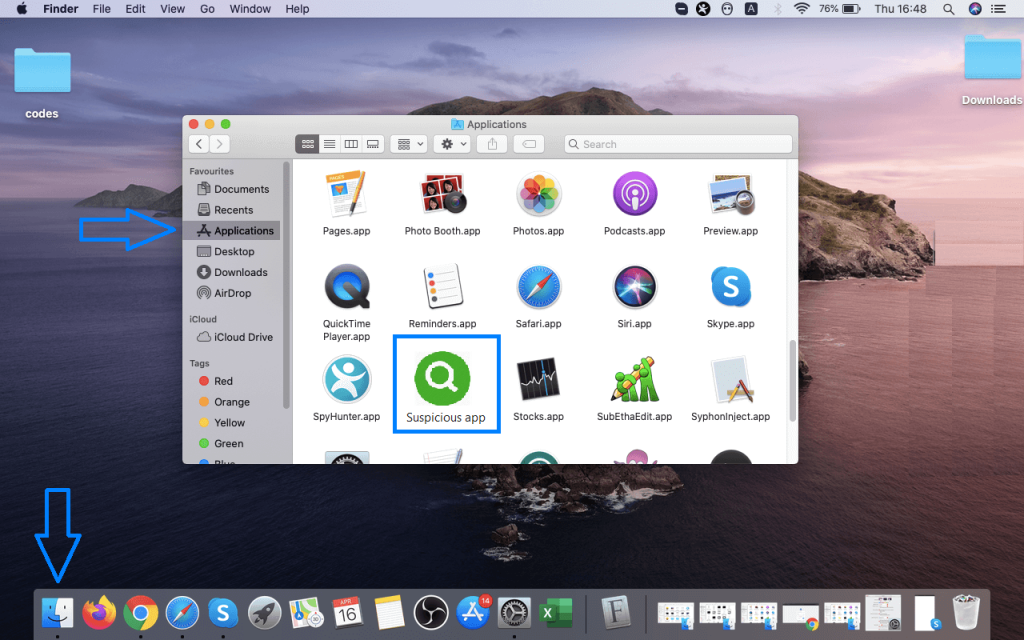
- 3. Мanually look for Search Baron in the Libraries of your Mac.
WARNING! You are about to tamper with Library files on Mac. Make sure that you know the name of the virus file. Deleting the wrong file may cause irreversible damage to your MacOS.
Select Go from the top menu bar and navigate to Go to Folder…
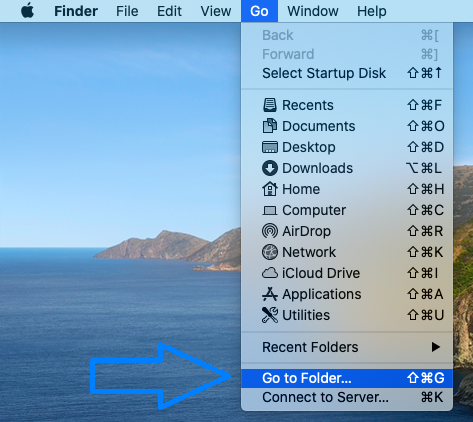
When the window appear start entering the following folder locations one by one:
/Library/Application Support
/Library/LaunchDaemons
~/Library/LaunchAgents
In each folder look for any recently-added suspicious files and move them to the Trash. Examples of files generated by adware:
- installmac.AppRemoval.plist
- myppes.download.plist
- mykotlerino.ltvbit.plist
- kuklorest.update.plist
Remove Search Baron From Your Browser
Remove suspicious browser extensions that can be responsible for the appearance of invasive pop-ups and browser redirects.
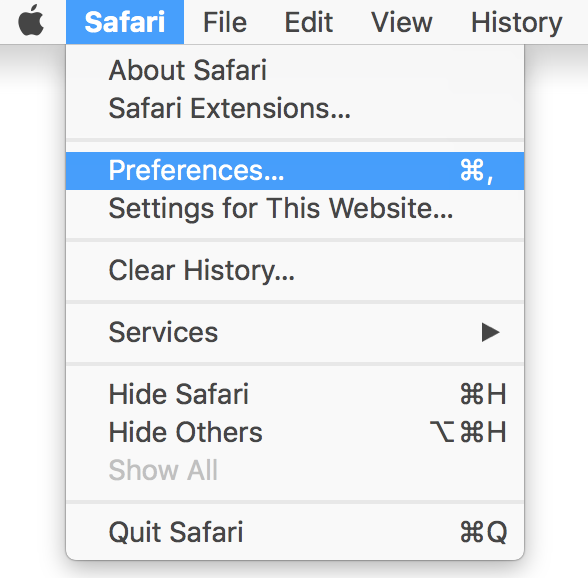
2. Click on the “Extensions” tab. If you see a suspicious or unwanted extension, select it and click “Uninstall“.
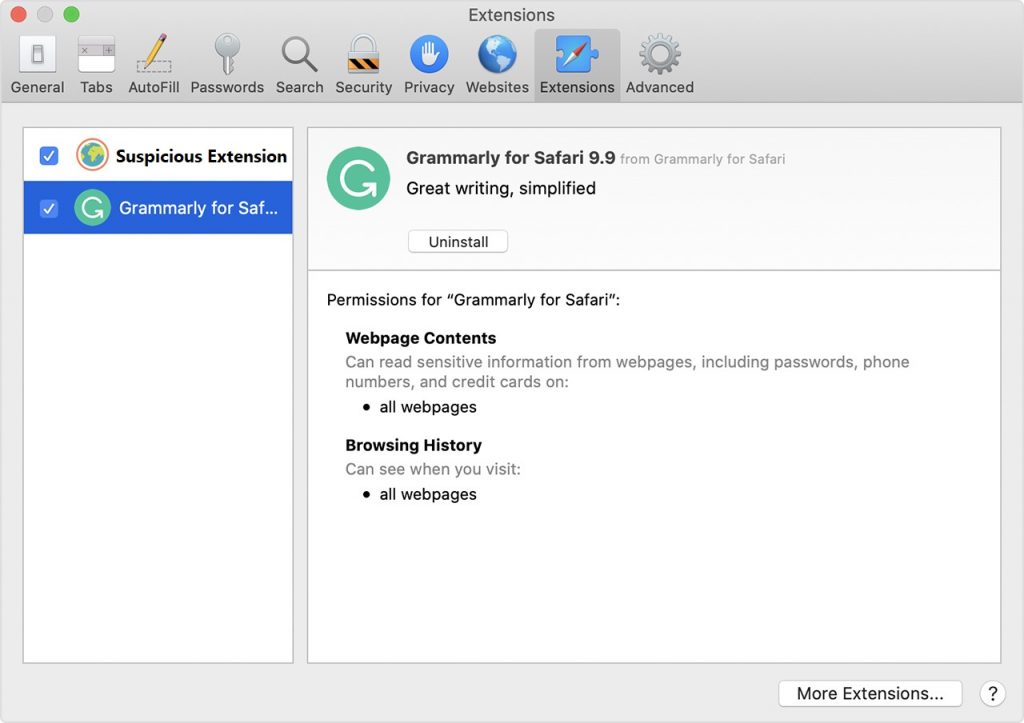
3. Reset Safari web browser. Beware that this step will remove the history as well as some of your saved data. Before you proceed we recommend that you make sure to write down all passwords, logins and important details.
If you are using Safari version 9 or higher open the browser and go to “Preferences“. Then select the “Privacy” tab. When the window appears on screen click on the “Remove All Website Data” button.
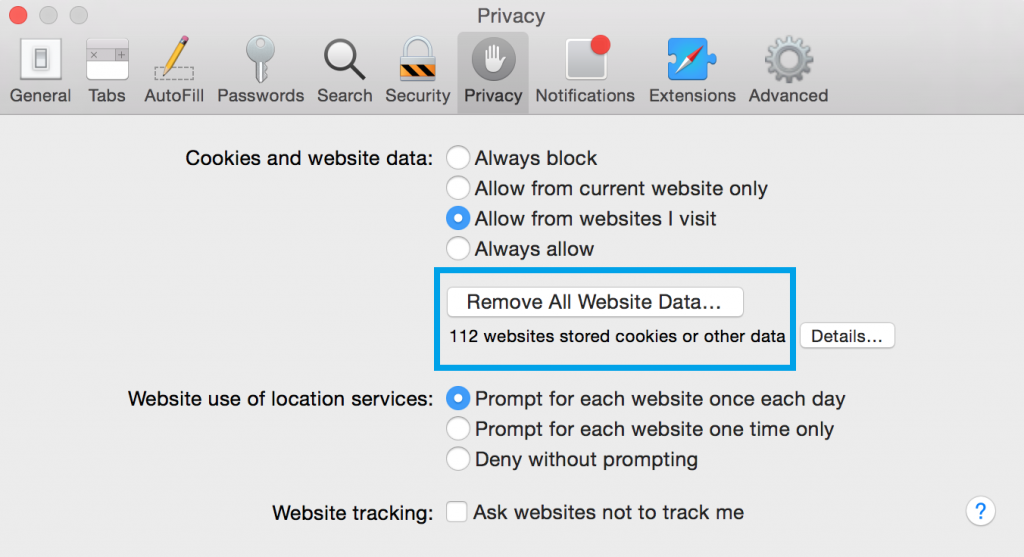
In case that your Safari web browser is running a version from 5 to 8, then just select Safari on the top menu bar and click on “Reset Safari” option. Choose which data to be cleaned from the browser.
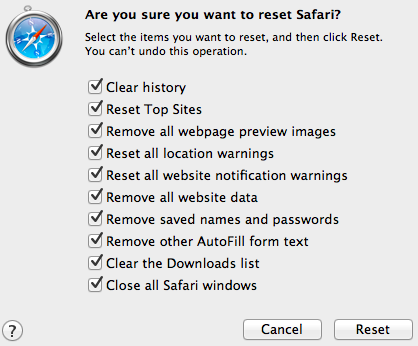

2. Click “Extensions” in the left menu. Then click on the trash bin icon to remove the suspicious extension.

3. Again in the left menu, under Chrome, Click on “Settings“. Go under “On Startup” and set a new page.

4. Afterward, scroll down to “Search“, click on “Manage search engines“.

5. In the default search settings list, find the unknown search engine and click on “X“. Then select your search engine of choice and click “Make default“. When you are ready click “Done” button in the right bottom corner.
1. Start Mozilla Firefox. In the upper right corner, click on the Open menu icon and select “Add-ons“.

2. Inside the Add-ons Manager select “Extensions“. Search the list of extensions for suspicious entries. If you find any, select them and click “Remove“.

3. Click again on the Open menu icon, then click “Options“.

4. In the Options window, under “General” tab, click “Restore to Default“.

5. Select “Search” in the left menu, mark the unknown search engine and press “Remove”.

Remove Search Baron from a Mac Automatically
While the above steps work very well in most of the cases when users’ OSX is infected with PUP or malware, sometimes the Mac virus removal requires the help of a professional application. This anti-malware tool will scan and remove malware from your Mac. It offers an active protection shield and comes with a variety of handy features that will keep your system fast, clean, and secure.
DOWNLOAD Antivirus for MacSpyHunter for Mac Scanner feature is free. Other features are paid. Here you can review its EULA and Privacy Policy.



